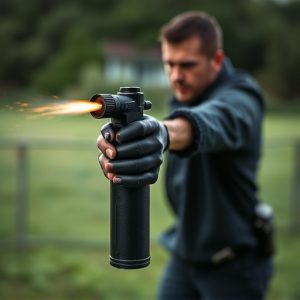Mastering Personal Safety: A Comprehensive Guide to Pepper Spray Use and Immediate Care
Pepper spray, a powerful self-defense tool using capsaicin from chili peppers, temporarily disables…….
Pepper spray, a powerful self-defense tool using capsaicin from chili peppers, temporarily disables attackers. To deploy effectively, aim for sensitive facial areas and follow Immediate Care steps: evacuate, remove contaminated clothing, rinse eyes with water for 15 minutes, seek fresh air if breathing is difficult, flush skin contact areas for 10-15 minutes, and remove shoes/socks. Legal considerations include checking local laws regarding possession; responsible ownership involves being prepared for Immediate Care after use to avoid legal repercussions and harm.
Personal safety is paramount in today’s world, and carrying inflammatory pepper spray is a proactive step. This powerful tool can be a game-changer during dangerous encounters. Our article delves into the intricacies of pepper spray, guiding you through its composition, effectiveness, and strategic use for self-defense. We explore crucial legal aspects and offer essential first aid advice for immediate care following exposure to ensure responsible ownership. By understanding these key elements, you’ll be better equipped to navigate potential threats with confidence.
- Understanding Pepper Spray: Its Composition and Effects
- When to Use Pepper Spray for Personal Safety
- Immediate Care and First Aid After Exposure
- Legal Considerations and Responsible Ownership
Understanding Pepper Spray: Its Composition and Effects
Pepper spray, also known as oleoresin capsicum (OC) spray, is a non-lethal self-defense tool designed to temporarily incapacitate an attacker. Its primary active ingredient is capsaicin, the compound that gives chili peppers their heat and spice. When deployed, pepper spray irritates the eyes, nose, and respiratory system, causing temporary blindness, coughing, and difficulty breathing. This immediate reaction allows users to escape from potentially harmful situations.
The composition of pepper spray includes a concentrated solution of capsaicin extracted from chili peppers, along with various other ingredients like water, alcohol, and thickening agents. These components ensure the spray forms a mist that can reach an attacker at close range. Immediate care after exposure involves flushing the affected area with water for at least 15 minutes to dilute the capsaicin. Seeking medical attention is advisable if symptoms persist or severe reactions occur.
When to Use Pepper Spray for Personal Safety
When faced with a dangerous situation, knowing when to deploy pepper spray can be a lifesaver. The immediate care aspect of pepper spray usage is crucial; it’s designed for quick, powerful protection against potential assailants. Whether you’re walking alone at night or in an area known for crime, carrying pepper spray offers a sense of security. It serves as a non-lethal deterrent, providing time to escape and seek help.
Effective use requires understanding the right moment to apply it. Aiming for the face, specifically the eyes, nose, and mouth, ensures maximum impact. The immediate care after usage involves washing affected areas with soap and water and seeking medical attention if necessary. Proper training in pepper spray handling and awareness of local laws regarding its possession is essential for responsible personal safety.
Immediate Care and First Aid After Exposure
If exposed to pepper spray, immediate care is crucial for mitigating discomfort and ensuring safe recovery. The first step is to move to a safe, open area away from the source of the spray. Remove any contaminated clothing or accessories, being careful not to rub or wipe the affected areas, as this can spread the irritant further. Rinse the eyes thoroughly with clean water for at least 15 minutes, lifting upper and lower eyelids occasionally to ensure all parts are washed. If breathing is difficult, seek fresh air immediately; you can also use a face mask if available.
For skin contact, flush the affected area with plenty of water for 10-15 minutes, gently washing away any visible spray residue. Remove contaminated shoes and socks, as well, to prevent further absorption through the feet. If irritation persists or worsens, seek medical attention promptly. Remember that immediate care can significantly alleviate symptoms associated with pepper spray exposure.
Legal Considerations and Responsible Ownership
When considering personal safety with inflammatory pepper spray, it’s crucial to understand legal considerations and responsible ownership. The legality of carrying pepper spray varies significantly from one jurisdiction to another; some areas permit its use for self-defense while others restrict or outright ban it. It’s essential to research and comply with local laws and regulations to avoid legal repercussions.
Responsible ownership goes hand in hand with understanding the immediate care required after using pepper spray. In the heat of the moment, users must be prepared to administer first aid to themselves or others who may have been affected. Immediate care for pepper spray exposure includes moving to a safe, well-ventilated area, removing contaminated clothing, and flushing eyes and skin with plenty of water for at least 15 minutes. Proper storage and secure keeping are also vital to ensure the safety of both the owner and others in the vicinity.
Pepper spray is a powerful tool for personal safety, but its responsible ownership and immediate care after exposure are paramount. By understanding its composition, knowing when to use it, and being prepared with proper first aid, individuals can maximize its effectiveness while minimizing risks. Always remember to stay informed about legal considerations and practice safe storage and disposal. When used appropriately, pepper spray can be a game-changer in potentially dangerous situations, ensuring your well-being and peace of mind.


